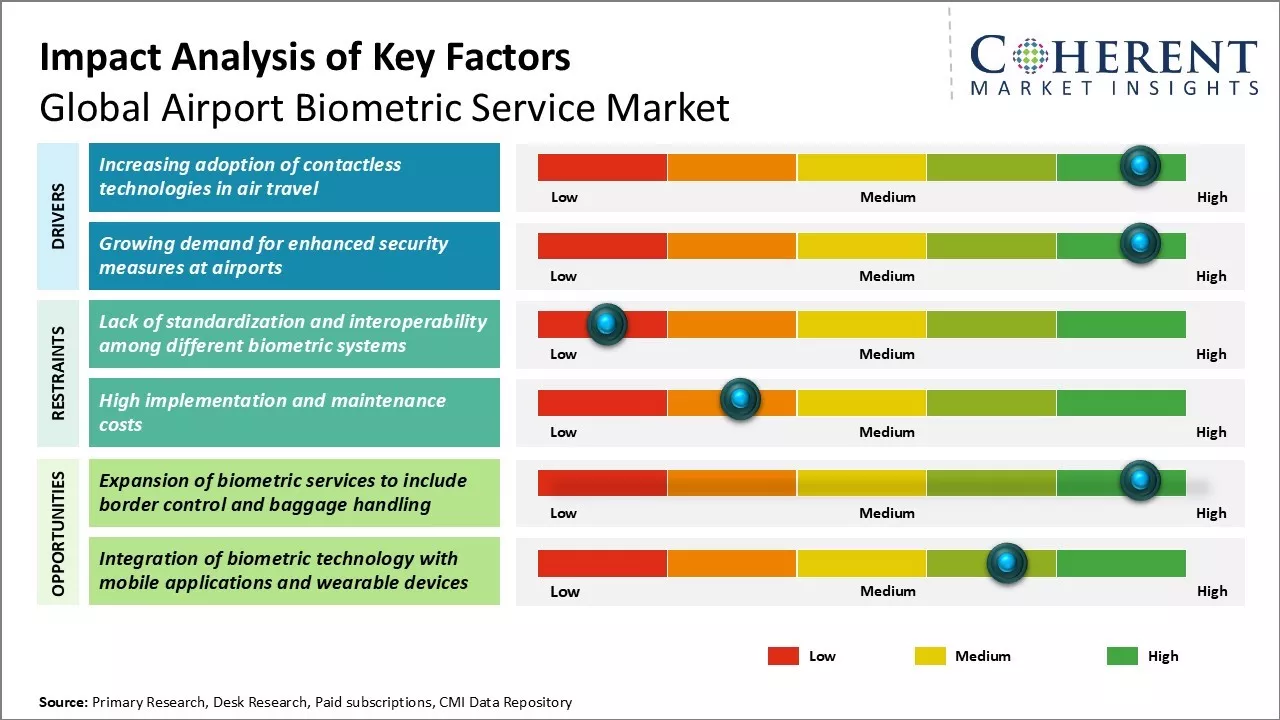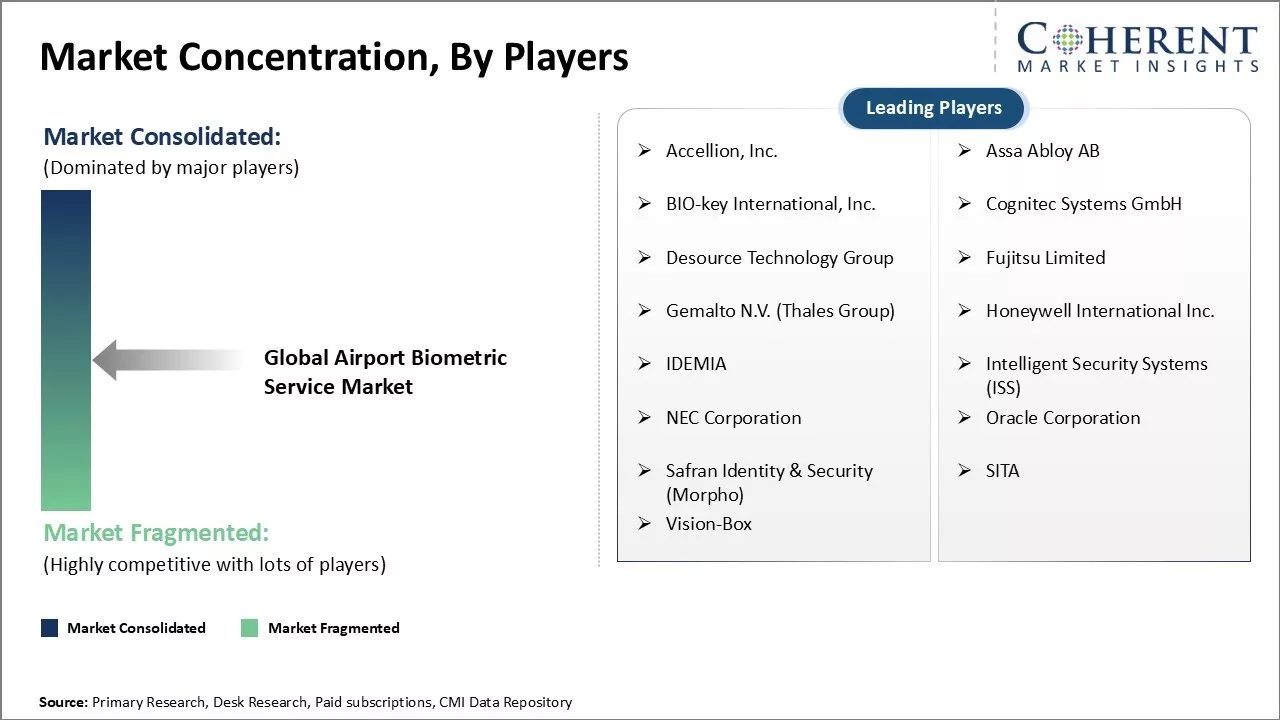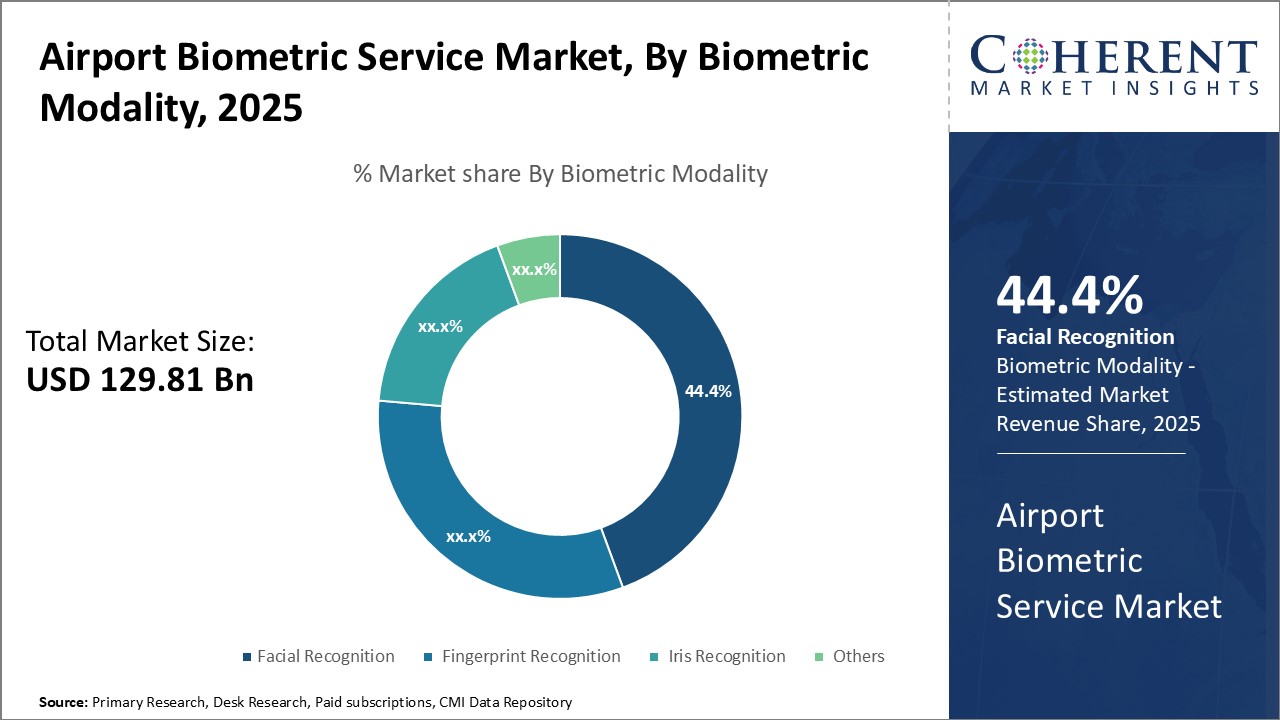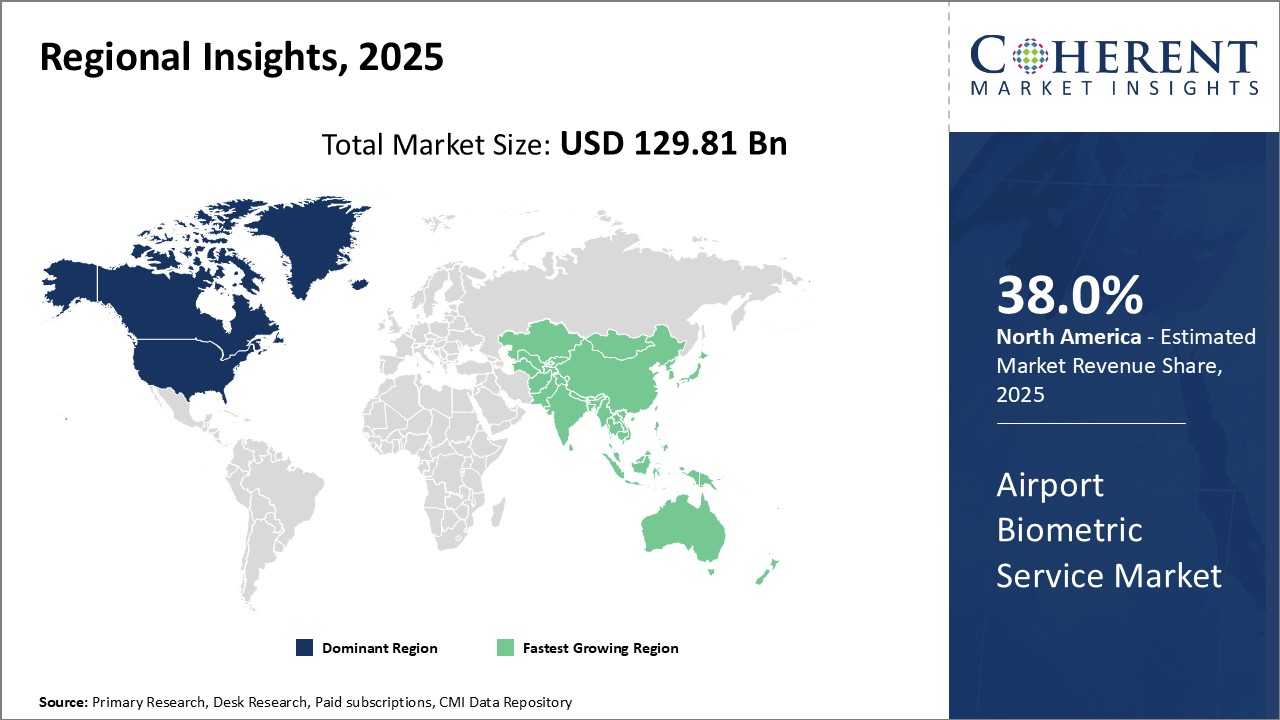Airport Biometric Service Market Size and Trends
Global airport biometric service market is estimated to be valued at USD 129.81 Billion in 2025 and is expected to reach USD 276.56 Billion by 2032, exhibiting a compound annual growth rate (CAGR) of 11.4% from 2025 to 2032.

Discover market dynamics shaping the industry: Download Free Sample
Global airport biometric service market growth is driven by factors such as increased focus on enhanced safety and security coupled with stringent government regulations across airports. Moreover, growing need for seamless and efficient passenger processing can boost adoption of biometric technologies at airports. Major airport operators worldwide are significantly investing in implementing advanced biometric solutions to improve customer experience. Advancements in cloud computing and edge AI can also drive the market growth by enabling improved biometric operations. Rising number of air passengers and focus on modernizing existing airport infrastructure can offer lucrative opportunities for airport biometrics service providers.
Market Driver - Increasing adoption of contactless technologies in air travel
Due to global pandemic, contactless technologies have become important across various industries including air travel. Airports around the world are adopting solutions that minimize physical contact between passengers and various airport touchpoints. This reduces the risk of transmission of viruses and leads to better passenger experiences.
Contactless solutions allow passengers to complete tasks like check-ins, security checks, and boardings in quick and hassle-free manners. Technologies like facial and iris recognition have enabled contactless boarding, where passengers can walk through gates without having to show IDs or tickets. This streamlines the boarding process tremendously. Airports are also rolling out solutions that allow contactless payment for shopping, parking, and lounges. Passengers can pay using mobile wallets, credit cards, or other digital Payments means without the need for touching payment machines or exchanging cash.
Even post-pandemic, these contactless solutions remained popular due to convenience these provide. Yo Airports also benefit from better throughput and operational efficiencies through contactless systems. With growing passenger numbers worldwide, contactless biometrics can help airports manage larger crowds seamlessly. More regional and smaller airports are anticipated to adopt contactless biometrics to enhance the overall passenger experience.
For instance, in January 2023, Philadelphia International Airport (PHL), in partnership with U.S. Customs and Border Protection (CBP), introduced facial biometric screening services at 25 boarding gates. This initiative represents the first implementation of contactless biometric technology in airports. It is designed to enhance security and streamline the boarding process for international travellers. The system verifies identities by comparing live facial scans to images already on file with the government, such as passport and visa photographs, thus, facilitating a more efficient travel experience.
Market Concentration and Competitive Landscape

Get actionable strategies to beat competition: Download Free Sample
Growing demand for enhanced security measures at airports
With evolving threats, there has been constant strive to install measures that can identify risky individuals and prevent security breaches. Biometric systems have shown great potential in strengthening security checks while also offering conveniences. Technologies like facial recognition, iris scanning, and fingerprint matching can identify individuals swiftly and accurately. When integrated with existing security platforms, biometric solutions can screen passengers against vast biometric databases for any alerts. This allows airport authorities to pinpoint possible criminals or persons of interest during the early stages.
Compared to traditional ID checks, biometrics provide security personnel with more reliable matches. Manually verifying IDs is time-consuming and prone to human errors. Biometrics make the process digital and automated. These help address the growing problem of forged or stolen identity documents. Biometric matching is extremely difficult to tamper with or circumvent illegally. The ability to positively identify security violators also aids in criminal investigations. Leading international airports have noticed decrease in security threats after implementing biometric boarding and watchlist screening processes. With rising passenger volume annually, there will be huge demand for security measures like biometrics at airports.
Key Takeaways from Analyst:
Global airport biometric service market growth is driven by increased security concerns and need for seamless travel. Governments across regions are implementing biometric technologies to screen and identify passengers more effectively. North America currently dominates the market, owing to stringent security regulations and heavy investments by airport authorities in the U.S. and Canada. However, Asia Pacific region is expected to emerge as the fastest growing market, with China and India installing biometric systems at major airports.
Biometric systems provide unmatched security and convenience but data privacy can hamper its universal adoption. Airport operators must assure passengers that their sensitive biometrics are fully encrypted and not shared with other organizations. High initial infrastructure costs of setting up biometric hubs and lack of necessary technical expertise in developing countries can hamper the market growth.
Rising global airline passenger traffic year-on-year can offer market growth opportunities. Growing demand from airports aspiring to upgrade legacy security systems and offer differentiated passenger experience can offer market growth opportunities for market players. Advancements in cloud technology and edge computing enables the development of more accurate and affordable biometric solutions.
Market Challenges: Lack of standardization and interoperability among different biometric systems
Global airport biometric service market growth can be hampered due to lack of standardization and interoperability among different biometric systems used across airports. Currently, there are no common standards adopted for storing, exchanging and matching biometric data between various systems. Each vendor has its own proprietary platform and database formats used for capturing and processing biometric information. This siloed approach creates issues in terms of sharing biometric data and templates between different airports and across systems of multiple vendors. The lack of interoperability acts as a hurdle for passengers travelling between countries as their biometric details captured at one airport may not be recognized at another airport. This leads to longer identification and verification processes, thus, reducing customer satisfaction. Harmonization of biometric standards will help in achieving seamless interoperability and facilitate faster passenger processing through a common framework for biometric data exchange globally.
Market Opportunities: Expansion of biometric services to include border control and baggage handling
Expansion of biometric services to include border control and baggage handling can offer market growth opportunities. Most airports utilize biometric technologies primarily for passenger identification during travel document checks. However, due to growing security concerns, there has been potential to leverage biometrics for automated processing at border control points through e-gates. This will help immigration authorities identify travellers quickly while ensuring security. Integrating biometric ID verification into baggage handling processes can help airlines and airports track passenger luggage efficiently and curb mishandling instances. The evolution towards providing end-to-end biometric-enabled traveller journey management spanning various touchpoints within the airport ecosystem can offer growth opportunities for stakeholders in the market.

Discover high revenue pocket segments and roadmap to it: Download Free Sample
Insights, By Biometric Modality - Rising Non-Invasive Biometric Technologies
In terms of biometric modality, facial recognition segment is estimated to contribute the highest market share of 44.4% in 2025, owing to its non-invasive nature and growing preference of travellers. Facial recognition allows verification of identity through digital images and videos without requiring physical contact, thus, making the process seamless and hassle-free. As airports experience rising passenger traffic worldwide, there has been huge need for biometric solutions that can authenticate large numbers of individuals quickly and efficiently. Facial recognition matches these capabilities well through contactless verification at immigration counters, boarding gates, and baggage claim areas. Its non-invasive design alleviates privacy concerns unlike fingerprint or iris scanning, thus, improving traveller satisfaction. Ongoing innovations enhances the speed, accuracy and coverage of facial recognition systems through 3D scanning and thermal sensors. Thus, more airports are installing facial verification portals for a convenient traveling experience.
Insights, By Application - Streamlining Traveler Flow with Passenger Verification
In terms of application, passenger verification segment is estimated to contribute the highest market share of 35.2% in 2025, as it helps optimize operations at airports. Biometric verification of boarding passes and travel documents enables queue-less boarding for flights through e-gates. This significantly reduces congestion at checkpoints and allows airports to process high volumes of passengers seamlessly. It further assists in curbside management and ensuring that only validated travellers accessed secured zones. This prevents security lapses and safeguards the infrastructure. With rising traffic putting pressure on existing airport facilities, passenger verification enhances throughput and passenger satisfaction through a swift travel process.
Insights, By End User - Ensuring Security through Government Mandates
In terms of end user, airport operators segment is estimated to contribute the highest market share of 52.9% in 2025, owing to stringent security regulations. Government agencies worldwide are mandating biometric checks at immigration entry and exit points to strengthen border security. This boosts demand from airport operators seeking biometric solutions for visa on arrival processes and integrated border management systems. Biometric matching of travellers against government databases helps detect fake travel documents and identify persons of interest. It also supports the implementation of digital identity schemes. Government projects and subsidies are supporting airport upgrades with contactless biometric technologies. This ensures airport operators deploy advanced solutions to comply with evolving security protocols for passenger and infrastructure protection.
Regional Insights

Need a Different Region or Segment? Download Free Sample
North America dominates the global airport biometric service market with an estimated market share of 38.0% in 2025, owing to strong infrastructure and early adoption of advanced technologies. Countries like the U.S. and Canada have airports with high passenger traffic that are continuously investing in improving passenger facilitation and ensuring safety. Major airports in key cities like New York, Los Angeles, Chicago, and others have fully integrated biometric based boarding and verification systems. This has streamlined processes and boosted overall traffic throughput.
The presence of major biometric solution providers and technology integrators in the region helped airports to opt for cutting edge services. Standardization efforts by the Department of Homeland Security have also pushed for biometric upgrades across all ports of entry. Biometrics is now an integral part of the air travel journey for North American flyers.
Asia Pacific region has emerged as the fastest growing market for airport biometric service. Countries with expanding economies like China, India and Indonesia are witnessing unprecedented growth in passenger air traffic. All major airports in these countries have ambitious expansion plans that include establishing biometric gates, kiosks and other touchless verification systems. Governments are actively supporting such modernization projects, with focus on establishing security, identity management and efficient processing of passengers.
Countries like India have launched unique digital identity programs that are uniquely linking citizens to their biometric details. This enhances the potential for contactless travel using biometrics. China invests heavily in developing advanced biometric technologies within its borders. Thus, solution providers within the Asia Pacific region are thriving with new opportunities. Standardization remains a challenge due to presence of multiple protocols. However, with coordinated efforts, Asia Pacific is expected to dominate global airport biometric installations in the near future.
Market Report Scope
Airport Biometric Service Market Report Coverage
| Report Coverage | Details | ||
|---|---|---|---|
| Base Year: | 2024 | Market Size in 2025: | USD 129.81 Bn |
| Historical Data for: | 2020 To 2024 | Forecast Period: | 2025 To 2032 |
| Forecast Period 2025 to 2032 CAGR: | 11.4% | 2032 Value Projection: | USD 276.56 Bn |
| Geographies covered: |
|
||
| Segments covered: |
|
||
| Companies covered: |
Accellion, Inc., Assa Abloy AB, BIO-key International, Inc., Cognitec Systems GmbH, Desource Technology Group, Fujitsu Limited, Gemalto N.V. (Thales Group), Honeywell International Inc., IDEMIA, Intelligent Security Systems (ISS), NEC Corporation, Oracle Corporation, Safran Identity & Security (Morpho), SITA, Vision-Box |
||
| Growth Drivers: |
|
||
| Restraints & Challenges: |
|
||
Uncover macros and micros vetted on 75+ parameters: Get instant access to report
Airport Biometric Service Industry News
- In March 2023, IDEMIA, a global leader in identity technologies, launched its comprehensive biometric system in eight major international airports worldwide. This innovative solution, designed to provide a seamless travel experience, integrates advanced facial recognition technology at every stage of the passenger journey, from check-in to boarding.
- In January 2023, Philadelphia International Airport (PHL), in collaboration with U.S. Customs and Border Protection (CBP), launched facial biometric screening services at 25 boarding gates. This initiative marks the first adoption of contactless biometric technology in airports, aimed at enhancing security and streamlining the boarding process for international travellers. The system verifies identities by comparing live facial scans with images already on file with the government, such as passport and visa photos, thus facilitating a more efficient travel experience.
- In January 2023, iGA Istanbul Airport, a prominent international aviation hub, announced collaboration with Turkish Airlines to test the Star Alliance's biometric access system. This partnership aims to provide passengers with a contactless travel experience, enhancing efficiency and convenience at the airport. The implementation of this advanced biometric technology aligns with iGA's commitment to improving the overall passenger journey through innovative solutions.
- In January 2023, IDEMIA, a leading global provider of identity technologies, announced the installation of its comprehensive biometric system in eight major international airports across Australia. This innovative solution aims to deliver a seamless travel experience by integrating advanced facial recognition technology at every stage of the passenger journey, from check-in to boarding.
*Definition: Global airport biometric service market provides biometric identification services to airports globally. These services primarily include facial recognition, fingerprint identification, iris scanning, and other biometric modalities to verify passenger identities. Airport biometric services help streamline passenger processing at checkpoints, facilitate seamless immigration clearance, and enhance security by identifying persons of interest through biometric watchlists.
Market Segmentation
- By Biometric Modality Insights (Revenue, USD Bn, 2020 - 2032)
-
- Facial Recognition
- Fingerprint Recognition
- Iris Recognition
- Others (Palm Vein, Voice Recognition, etc.)
- By Application Insights (Revenue, USD Bn, 2020 - 2032)
-
- Passenger Verification
- Employee Identification
- Baggage Tracking
- Border Control
- Others (Automated Border Control, Security Screening, etc.)
- By End User Insights (Revenue, USD Bn, 2020 - 2032)
-
- Airport Operators
- Government Agencies
- Airlines
- By Regional Insights (Revenue, USD Bn 2020 - 2032)
- North America
- U.S.
- Canada
- Latin America
- Brazil
- Argentina
- Mexico
- Rest of Latin America
- Europe
- Germany
- U.K.
- Spain
- France
- Italy
- Russia
- Rest of Europe
- Asia Pacific
- China
- India
- Japan
- Australia
- South Korea
- ASEAN
- Rest of Asia Pacific
- Middle East
- GCC Countries
- Israel
- Rest of Middle East
- Africa
- South Africa
- North Africa
- Central Africa
- North America
- Key Players Insights
-
- Accellion, Inc.
- Assa Abloy AB
- BIO-key International, Inc.
- Cognitec Systems GmbH
- Desource Technology Group
- Fujitsu Limited
- Gemalto N.V. (Thales Group)
- Honeywell International Inc.
- IDEMIA
- Intelligent Security Systems (ISS)
- NEC Corporation
- Oracle Corporation
- Safran Identity & Security (Morpho)
- SITA
- Vision-Box
Share
Share
About Author
Ankur Rai is a Research Consultant with over 5 years of experience in handling consulting and syndicated reports across diverse sectors. He manages consulting and market research projects centered on go-to-market strategy, opportunity analysis, competitive landscape, and market size estimation and forecasting. He also advises clients on identifying and targeting absolute opportunities to penetrate untapped markets.
Missing comfort of reading report in your local language? Find your preferred language :
Transform your Strategy with Exclusive Trending Reports :
Frequently Asked Questions
EXISTING CLIENTELE
Joining thousands of companies around the world committed to making the Excellent Business Solutions.
View All Our Clients
